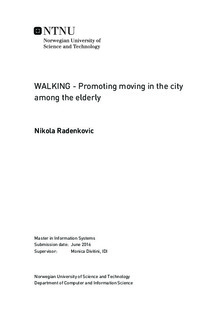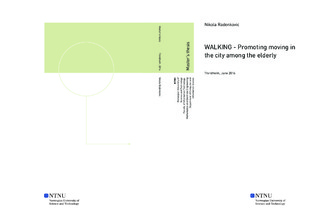| dc.description.abstract | This project and accompanying research was developed with a purpose of discovering useful aspects in designing software systems for elders, used to encourage daily walking as a fall prevention. The idea was to try to utilize social and reflection aspects into the software system design process, while also incorporating playfulness and some other guidelines for intuitive design, in order to produce both appealing and motivating software for the elders.
In order to discover how to make the software more appealing and motivating for elders, two problems were elaborated. One was a possible barrier in use of assistive systems and innovative technology in elders and the other was a barrier in motivation for daily walking. Four specific issues that could apply to software system were extracted from the first and four from the second problem. Then, the solution proposal is written, trying to deal with all of those specific issues by utilizing social and reflection aspect incorporated into the idea of the system. The ideas of how to utilize social aspect in order to deal with a barrier in use of assistive systems, and about how to use both social and reflection aspects to increase motivation are developed, based on the literature review done by me in specialization project on this topic, creative thinking and brainstorming with goal to produce useful solution ideas.
Proposed solutions and insight gained from related work are then used to develop corresponding software system concepts that were supposed to represent those ideas in a more practical form and be used as a bridge between proposed solution and system prototype that was developed later. Concepts are presented with drawings and explanations of how software should look and feel like from the perspective of a designer. Initial concepts are then evaluated with an expert in this field and received feedback was used in redesign process to improve the existing concepts.
Software engineering methods, guidelines and standards are used in prototype development in order to, first, define requirements specifications based on the final concepts, then make an architectural description as a form of software architecture engineering process in order to figure out how to incorporate all requirements into a single software in a form of mobile application and in the third phase, prototype implementation is performed according to requirements and architectural decisions resulting in an Android application prototype that could be used as an artifact for demonstrating proposed solutions to the elders as end users.
Evaluation of prototype is performed with users using survey, and the resulting data is collected anonymously and presented. The resulting data is then used to discuss about how and why certain features as representations of proposed solutions, are useful or not useful in dealing with issues described in the beginning.
Results suggested that social support and information support types of social interaction could be beneficial in making the software system more appealing in some elders, while reflection-in-action and reflection-on-action forms of reflection aspect could be beneficial for increasing the motivation for walking in elders and adding a social traces suggested even further motivation levels increasing in some of the users. Playfulness concept developed in this project gave a bad result in making the software appealing, as evaluated users did not like it. However, some additional features, as having a user manual, offering both free and paid version of the software, including a goal that can be worked on and achieved and providing emotional reinforcement as reward, seem to be a useful feature to think about when designing this type of software. | |

